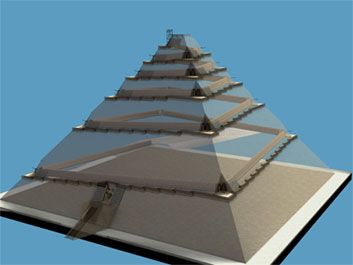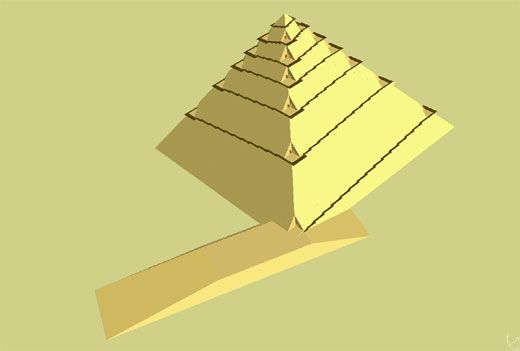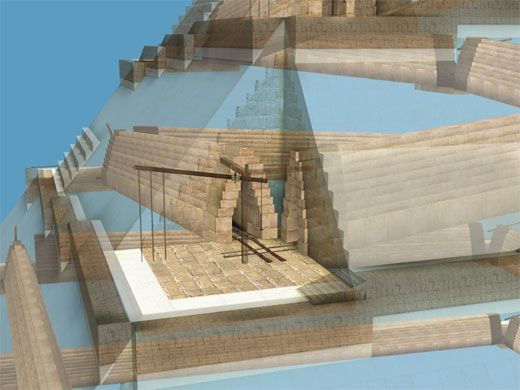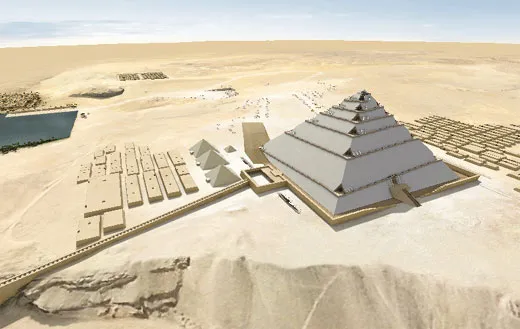Monumental Shift
Tackling an ages-old puzzle, a French architect offers a new theory on how the Egyptians built the Great Pyramid at Giza
/https://tf-cmsv2-smithsonianmag-media.s3.amazonaws.com/filer/pyramid_main_388.jpg)
In 1999, Henri Houdin, a retired French civil engineer, was watching a television documentary on the construction of Egypt's ancient pyramids. He had supervised many dam and bridge projects, and much of what he saw on the show struck him as impractical. "It was the usual pyramid-building theories, but he wasn't satisfied as an engineer," says his son, Jean-Pierre, an independent architect. "He had a sparkle in the brain. 'If I had to build one now, I would do it from the inside out.' "
Jean-Pierre Houdin realized he could test the feasibility of his father's idea through computer-based 3-D modeling. That's what he set out to do, taking for his model the Great Pyramid at Giza. His inquiry grew into a passionate quest to solve a puzzle that has baffled humankind for ages: how exactly was the Great Pyramid built? Houdin thinks he's figured it out, and that his father was onto something.
The Great Pyramid rose 4,500 years ago on the Giza plateau, just outside Cairo, to house the tomb of the pharaoh Khufu (called Cheops by the Greeks). Covering 13 acres and originally 481 feet high, it survives as the last of the "seven wonders" of the ancient world. Its technical precision amazes modern architects and engineers, especially in light of the available resources. The pyramid's 2.3 million limestone blocks, most weighing more than two tons, were cut and hauled into place without the benefit of wheels, pulleys and iron tools.
After visiting Khufu's pyramid around 450 B.C., the Greek historian Herodotus surmised that 100,000 slaves spent 20 years building it. Many modern Egyptologists view that time frame as reasonable. But the notion that slaves did the work—long a myth of schoolbooks—has been discredited. Researchers now regard Egypt's pyramids as huge public works projects, to which all households in the kingdom provided workers, food and supplies.
Various studies have analyzed logistical movements, labor organization and the use of wooden sledges, ramps, levers and other devices to help explain pyramid construction. Some studies suggest that the work force may have been a fifth or a tenth of Herodotus' estimate. Yet the overall process by which the workers assembled the Great Pyramid remains a mystery.
To make his 3-D models of pyramid construction faithful to methods of the past and prevailing knowledge in the field, Houdin consulted with Egyptologists. Five years into the project, Dassault Systèmes, a French software company that makes 3-D models for cars and airplanes, stepped in to offer support. The company's software engineers spent 5,000 hours helping Houdin compile 3-D computer simulations to verify his ideas.
"The objective was to say, if we had to build the pyramid today using Jean-Paul's theories, would it be possible?" says Mehdi Tayoubi, a creative director at Dassault. "We found it would be."
Houdin announced the results of his study, which has not yet been published in a scientific journal, in March at a press conference in Paris. Members of the audience donned 3-D glasses to follow Houdin "inside" the Great Pyramid as he explained his view of how it was built. (His father, now 84, attended the event.)
As Houdin sees it, the process worked like this: First, workers used a conventional straight ramp to haul and assemble the large stone blocks for the pyramid's base layers, up to 141 feet; at that level, nearly three-fourths of the structure's total volume would be complete. That took about ten years. Next came construction of the interior King's Chamber—a separate engineering challenge because its ceiling incorporated granite beams weighing up to 60 tons each.
In the final stage, Houdin contends, the builders reached the steep upper layers of the pyramid by means of spiraling internal ramps, or tunnels. Stone blocks from the external ramp, he believes, were cut smaller to fill the top spaces. "At the end you have no waste," he says. "That's why we never found any remains at the site."
External ramps figure in many previous theories of pyramid-building. One favors the use of a straight frontal ramp extending from the base to the summit; alternative approaches involve external ramps that zigzag up the triangular faces of a pyramid or spiral around the sides like a corkscrew. But all these theories have drawbacks, according to Bob Brier, an archaeologist at Long Island University who described Houdin's theory in the May/June issue of Archaeology.
A straight frontal ramp would require too much stone and labor if built to the full height of a pyramid, he explains. To maintain a manageable grade of 6 to 8 percent for the incline—the maximum slope of modern highways—such a ramp would have to extend a mile or more. Ramps surrounding a pyramid might block sight lines the builders needed to ensure their measurements were accurate, or be prone to collapsing.
Brier thinks Houdin has made a compelling case in his engineering analysis. "It's a radical idea, because of the ramp being internal, but it's possible, and it's worthy of being tested," Brier says. "It's not a perfect theory, but I think it's the most interesting archaeological theory we've had in a very long time."
Brier says he remains skeptical about whether internal passageways would have allowed the pyramid builders enough room to maneuver heavy stone blocks.
Craig B. Smith, an engineer who wrote How the Great Pyramid Was Built, also has some doubts about the new theory. "It adds an unnecessary degree of complexity, and I think of the ancient Egyptians as practical builders who reduced things to simple, practical approaches," says Smith. "Also, there is no evidence that internal ramps were used in any pyramid built before the Great Pyramid, or after."
Houdin is confident that internal passageways remain inside the Great Pyramid, obscured by outer layers of stones. He plans to test for their presence using non-invasive technologies such as infrared photography, radar, sonar and microgravimetry, which can detect hidden spaces in solid structures by measuring differences in density.
In partnership with archaeologists from around the world, Houdin applied for permission to do an on-site survey. He expects to get the go-ahead from Egyptian authorities in the next year or two.
Houdin has presented his theory to Zahi Hawass, secretary general of Egypt's Supreme Council on Antiquities. In the foreword to a recent book by Houdin, Khufu: The Secrets Behind the Building of the Great Pyramid, Zawass calls the work "an interesting, potentially promising, new line of investigation."
Diana Parsell is a writer and editor in Falls Church, Virginia.



